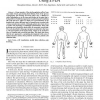Free Online Productivity Tools
i2Speak
i2Symbol
i2OCR
iTex2Img
iWeb2Print
iWeb2Shot
i2Type
iPdf2Split
iPdf2Merge
i2Bopomofo
i2Arabic
i2Style
i2Image
i2PDF
iLatex2Rtf
Sci2ools
TITB
2008
2008
3-D Pain Drawings--Mobile Data Collection Using a PDA
A large number of the adult population suffers from some kind of back pain during their lifetime. Part of the process of diagnosing and treating such back pain is for a clinician to collect information as to the type and location of the pain that is being suffered. Traditional approaches to gathering and visualizing this pain data have relied on simple 2-D representations of the human body, where different types of sensation are recorded with various monochrome symbols. Although patients have been shown to prefer such drawings to traditional questionnaires, these pain drawings can be limited in their ability to accurately record pain. The work described in this paper proposes an alternative that uses a 3-D representation of the human body, which can be marked in color to visualize and record the pain data. This study has shown that the new approach is a promising development in this area of medical practice and has been positively received by patients and clinicians alike.
Human Body | Pain | Pain Data | TITB 2008 |
| Added | 15 Dec 2010 |
| Updated | 15 Dec 2010 |
| Type | Journal |
| Year | 2008 |
| Where | TITB |
| Authors | George Ghinea, Fotis Spyridonis, Tacha Serif, Andrew O. Frank |
Comments (0)

